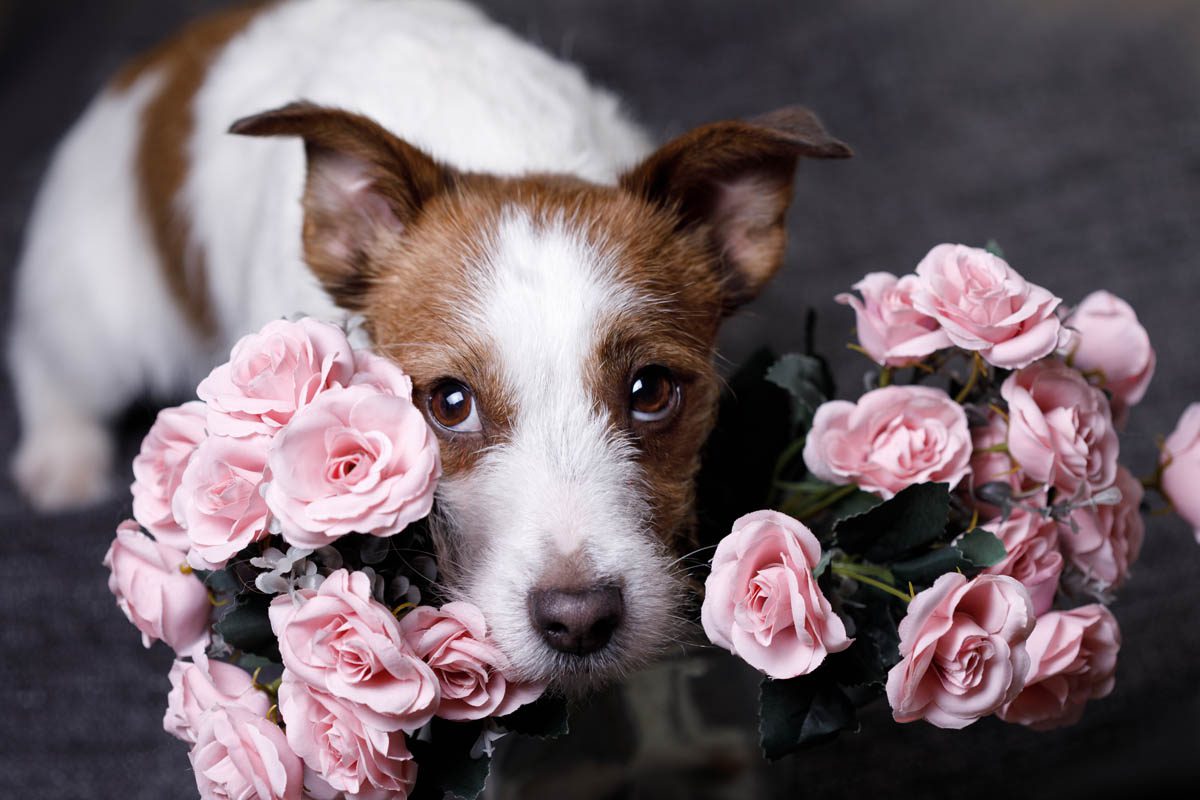Roses (Rosa spp.) are non-toxic to dogs. These garden and cut flower favourites are safe to keep around dogs and make a great choice for the garden and as a cut flower.
Interestingly, the fruit that grows on the blossom of a wild rose (Rosa canina) known as rosehip contains antiinflammatory properties and is commonly used to treat arthritis in dogs.
What are roses?

- Family: Rosaceae
- Scientific name: Rosa spp.
Common names: Rose, rose bush, climbing rose - Toxic parts: None, however, the thorns can penetrate the skin and eyes
- Toxicity: Non-toxic
Roses are a species of perennial shrub made up of approximately 350 species that are believed to have originated from Central Asia. They are widely cultivated for their decorative and scented flowers which are used in scented products.
Rose petals are the main ingredient in rosewater, which is used in Turkish delight, fresh petals are used as garnishes, and dried petals are often consumed as tea.
What are the risks of roses to dogs?
Puppies are at increased risk due to their naturally curious nature, but some dogs will chew anything.
Consumption of the rose flower or leaves is harmless to dogs, but thorns can penetrate the delicate oral mucosa causing pain and in some cases, infection or abscess. Avoid the use of water preservers, snail and slug pellets and pesticides on roses or around plants that dogs have access to, as most are toxic to pets.
Are all roses non-toxic to dogs?
Not all plants with rose in their name belong to the rose family. The scientific name for rose is Rosa and all plants in this family are non-toxic.
- Christmas rose (Hellebore spp.) – Toxic
- Moss rose (Portulaca) – Toxic
- Rose of Sharon (Hibiscus syriacus) – Toxic
- Rosemary (Salvia rosmarinus) – Non-toxic
- Alpen rose (Rhodedendron ferrugineum) – Toxic
Other flowers non-toxic to dogs
Plants and flowers get a bad rap as many are toxic to pets. While many are only mildly toxic, a small number can be deadly and should not be kept in homes with dogs. These include lilies, foxglove and oleander. The good news is that a lot of flowers are completely safe to keep in homes or gardens around dogs.
- Kangaroo paw (Anigozanthos flavidus)
- Snapdragon (Antirrhinum majus)
- Cornflower (Centaurea cyanus)
- Cosmos (Cosmos bipinnatus)
- Gerbera (Gerbera spp.)
- Sunflower (Helianthus spp.)
- Jasmine (Jasminum officinale)
- Forget-me-not (Myosotis spp.)
- Orchids (Orchidaceae spp.)
- Lilac (Syringa vulgaris)
- African violet (Saintpaulia spp.)
- Zinnia (Zinnia spp.)
Keeping dogs safe around plants
Many popular house and garden plants are toxic to dogs. The toxicity can range from mild to fatal. Some of the most toxic plants to dogs include:
- Rosary bean (Abrus precatorius)
- Monkshood (Aconitum spp.)
- Deadly nightshade (Atropa belladonna)
- Angel’s trumpet (Brugmansia spp.)
- Jessamine (Cestrum spp.)
- Water hemlock (Cicuta spp.)
- Autumn crocus (Colchicum autumnale)
- Sago palm (Cycas revoluta)
- Daphne (Daphne spp.)
- Delphinium (Delphinium spp.)
- Foxglove (Digitalis purpurea)
- Coral tree (Erythrina spp.)
- Snakeshead (Fritillaria meleagris)
- Climbing lily (Gloriosa spp.)
- Heliotrope (Heliotropum arborescens)
- Lantana (Lantana camera)
- Cardinal flower (Lobelia spp.)
- Chinaberry (Melia azedarach)
- Star of Bethlehem (Ornithogalum spp.)
- Mayapple (Podophyllum peltatum)
- Rhododendron (Rhododendron spp.)
- Castor oil plant (Ricinus communis)
- Periwinkle (Vinca spp.)
- Death camas (Zigadenus spp.)
Pet owners should always check the safety of plants and flowers brought into the house and garden. It is always safest to avoid bringing toxic plants into homes with cats or dogs, but in some cases, it may be okay as long as the dog doesn’t have access to the plant.
What to do if a dog ingests a toxic plant?
Because the toxicity of plants can range from mild to severe, it is always recommended you contact a veterinarian or pet poison helpline for advice. In some cases, they may recommend a wait-and-see approach to see if clinical signs develop.
Ingestion of highly toxic plants will require immediate veterinary care. The sooner the dog is treated, the better the outcome. Early intervention will include gastrointestinal decontamination to prevent further absorption as well as activated charcoal to bind to any remaining plant matter. Additional treatment will depend on the toxin as well as clinical signs.
Julia is a writer and landscape consultant from Wollongong with a love of horticulture. She had been an avid gardener for over 30 years, collects rare variegated plants and is a home orchardist. Julia is passionate about learning and sharing her knowledge of plant propagation and plant toxicology. Whether it’s giving advice on landscape projects or sharing tips on growing, Julia enjoys helping people make their gardens flourish.




